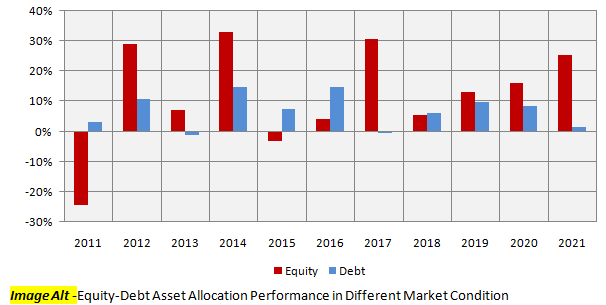Should you invest in Balanced Advantage Funds

Balanced Advantage Funds, also known as Dynamic Asset Allocation Funds, are hybrid mutual funds which manage their asset allocation dynamically between equity and debt. The asset allocation will change depending on market conditions using quantitative asset allocation models.
Why should you invest in Balanced Advantage Funds?
- You can see in the chart below that, different asset classes outperform / underperform in different market conditions. Balanced Advantage Funds dynamically change asset allocation depending on market conditions to generate superior risk adjusted returns for investors.
![Different asset classes outperform / underperform in different market conditions Different asset classes outperform / underperform in different market conditions]()
Source: National Stock Exchange, Advisorkhoj Research, as on 31st December 2021. Nifty 50 TRI has been used as proxy for equity as an asset class; Nifty 10 Year Benchmark G-Sec Index has been used as proxy for debt as an asset class. Disclaimer: Past performance may or may not be sustained in the future.
- Balanced advantage funds can reduce volatility of your portfolio in bear markets compared to equity and aggressive hybrid funds.
- Balanced Advantage Funds follow quantitative models (back-tested across different market conditions) for managing asset allocation without relying on human judgement.
- Balanced advantage funds usually enjoy equity taxation. However, you should consult with your financial advisor to know the taxation of specific schemes.
How these funds manage their asset allocation?
- Active (net) equity: Active equity allocation or equity allocation net of hedging is determined by the dynamic asset allocation model (we will discuss this in more detail later).
- Fixed income: Fixed income or debt allocation is usually capped at 35% to avoid non equity taxation.
- Arbitrage: This is the fully hedged equity component which is not exposed to market risks. Derivatives are used for arbitrage. The arbitrage component not only reduces risk, it also generates risk-free profits based on price differences in cash and derivatives market. Arbitrage also enables these schemes to enjoy equity taxation.
What asset allocation models are used by these funds?
Dynamic Asset Allocation refers to changing equity and debt allocations depending on market conditions. The aim of dynamic asset allocation is to reduce downside risk and generate risk adjusted returns for investors. Two types of dynamic asset allocation models are mainly used:-
- Counter-cyclical model: Counter-cyclical models increase equity allocation (reduce debt allocation) in falling markets (lower valuations) and reduce equity allocations in rising markets (higher valuations). These models essentially aim at buying low and selling high. Different fund managers use different valuation metrics for dynamic asset allocation e.g. P/E, P/B etc.
- Pro-cyclical model: Pro-cyclical models essentially try to follow the trend. Funds employing pro-cyclical models increase their equity allocation in rising markets and reduce it in falling markets. Pro-cyclical models are based on market trend indicator (Daily Moving Averages) and indicators of the trend strength / health (Standard Deviation, Downside Deviation etc.). Some pro-cyclical models may use other factors like valuations, macro-economic factors etc.
Which asset allocation model is better for you?
Counter-cyclical models buy when prices are cheap and sell when prices are expensive. The underlying logic in pro-cyclical approach is that market follows broad trends. In bull market, stock prices tend to go higher even if valuations are expensive. Similarly in a bear market, prices may continue to fall, even though valuations may appear to be very cheap. Pro-cyclical asset allocation aims to maximize returns in bull markets and tries to limit downside in bear markets by shedding risks quickly.
While counter-cyclical models are less volatile in short corrections, pro-cyclical models may see lesser draw downs in deeper and longer corrections e.g. 2008 Global Financial Crisis. In a bear market, counter cyclical schemes will keep increasing equity exposure as market continues to fall and losses may increase. Pro-cyclical models on the other hand, will shed risks when market falls. You should consult your financial advisor and make informed investment decision.
Will Balanced Advantage Funds be suitable in these market conditions?
- There is uncertainty in global equity markets due the crisis in Ukraine and economic sanctions on Russia. Balanced advantage funds may reduce downside risk in these conditions.
- High inflation and trajectory of interest rates constitute additional risks for global equities in the near term. As such, balanced advantage funds may be suitable investment options in such conditions.
- Economies around the world were on the post COVID recovery path when this crisis struck. Pro-cyclical balanced advantage funds will be well placed when the market bounces back from its bottom.
Should you invest in Balanced Advantage Funds?
Balanced Advantage Funds is suitable for you:-
- If you want capital appreciation and income over long investment horizons.
- If you do not have appetite for very high volatility.
- If you have moderately high risk appetites.
- If you have minimum 3 year investment tenures.
Consult with your financial advisor if you need help in understanding the risk profile of your scheme; invest according to your risk appetite and investment needs.
An investor education initiative by Edelweiss Mutual Fund
All Mutual Fund Investors have to go through a onetime KYC process. Investor should deal only with Registered Mutual Fund (RMF). For more info on KYC, RMF and procedure to lodge/redress any complaints, visit - https://www.edelweissmf.com/kyc-norms
Mutual Fund Investments are subject to market risk, read all scheme related documents carefully.
EAML is amongst the fastest growing asset management companies, being an asset management subsidiary of Edelweiss Financial Services Ltd., one of Indias leading financial services group since last 21 years with a proven track record of quality and innovation. Edelweiss AML is present across 11 locations across the country. EAML offers a suite of differentiated asset management products and the unique knowledge proposition focusing on building a strong connect with Distributors and customers. At Edelweiss AMC, the aim is to come up with truly innovative ideas that doesnt exist today and bridge the gap between what investors want and what the industry has to offer.
Quick Links
Contact Us
- Toll Free : 1800 425 0090
- Non Toll Free : +91-40-23001181
- EMFHelp@edelweissfin.com
- distributor.amc@edelweissfin.com
POST A QUERY






